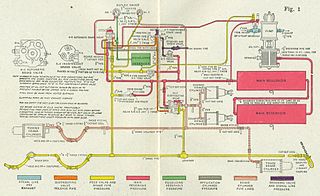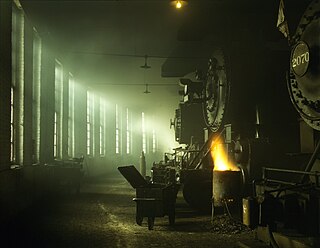
The Interstate Commerce Commission (ICC) was a regulatory agency in the United States created by the Interstate Commerce Act of 1887. The agency's original purpose was to regulate railroads to ensure fair rates, to eliminate rate discrimination, and to regulate other aspects of common carriers, including interstate bus lines and telephone companies. Congress expanded ICC authority to regulate other modes of commerce beginning in 1906. Throughout the 20th century, several of ICC's authorities were transferred to other federal agencies. The ICC was abolished in 1995, and its remaining functions were transferred to the Surface Transportation Board.

A railway air brake is a railway brake power braking system with compressed air as the operating medium. Modern trains rely upon a fail-safe air brake system that is based upon a design patented by George Westinghouse on April 13, 1869. The Westinghouse Air Brake Company was subsequently organized to manufacture and sell Westinghouse's invention. In various forms, it has been nearly universally adopted.

The Timeline of U.S. Railway History depends upon the definition of a railway, as follows: A means of conveyance of passengers and goods on wheeled vehicles running on rails, also known as tracks.
Rail terminology is a form of technical terminology. The difference between the American term railroad and the international term railway is the most significant difference in rail terminology. These and other terms have often originated from the parallel development of rail transport systems in different parts of the world. In English-speaking countries outside the United Kingdom, a mixture of US and UK terms may exist.

Wooden railroads, called wagonways, were built in the United States starting from the 1720s. A railroad was reportedly used in the construction of the French fortress at Louisburg, Nova Scotia, in New France in 1720. Between 1762 and 1764, at the close of the French and Indian War (1756–1763), a gravity railroad called Montresor's Tramway was built by British military engineers up the steep riverside terrain near the Niagara River waterfall's escarpment at the Niagara Portage in Lewiston, New York.

The United States Railroad Administration (USRA) was the name of the nationalized railroad system of the United States between December 28, 1917, and March 1, 1920. It was the largest American experiment with nationalization, and was undertaken against a background of war emergency following American entry into World War I. During its brief existence, the USRA made major investments in the United States railroad system, and introduced standardized locomotive and railroad car classes, known as USRA standard. After the end of World War I, while some in the United States advocated for continuing nationalization, ultimately the railroads were returned to their previous owners in early 1920.

A coupling is a mechanism typically placed at each end of a railway vehicle that connects them together to form a train. A variety of coupler types have been developed over the course of railway history. Key issues in their design include strength, reliability, ease of making connections and operator safety.

The Hammond Circus Train Wreck occurred on June 22, 1918, and was one of the worst train wrecks in U.S. history. Eighty-six people were reported to have died and another 127 were injured when a locomotive engineer fell asleep and ran his troop train into the rear of a circus train near Hammond, Indiana. The circus train held 400 performers and roustabouts of the Hagenbeck–Wallace Circus.
Automatic train stop or ATS is a system on a train that automatically stops a train if certain situations occur to prevent accidents. In some scenarios it functions as a type of dead man's switch. Automatic train stop differs from the concept of Automatic Train Control in that ATS usually does not feature an onboard speed control mechanism.

The Interstate Commerce Act of 1887 is a United States federal law that was designed to regulate the railroad industry, particularly its monopolistic practices. The Act required that railroad rates be "reasonable and just," but did not empower the government to fix specific rates. It also required that railroads publicize shipping rates and prohibited short haul or long haul fare discrimination, a form of price discrimination against smaller markets, particularly farmers in Western or Southern Territory compared to the Official Eastern states. The Act created a federal regulatory agency, the Interstate Commerce Commission (ICC), which it charged with monitoring railroads to ensure that they complied with the new regulations.

The Diamond and Caldor Railway was a common carrier 3 ft narrow gauge railroad operating in El Dorado County, California, in the United States. The 34-mile railroad was primarily a logging railroad but also operated some passenger service.
This article contains a list of terms, jargon, and slang used to varying degrees by railfans and railroad employees in the United States and Canada. Although not exhaustive, many of the entries in this list appear from time to time in specialist, rail-related publications. Inclusion of a term in this list does not necessarily imply its universal adoption by all railfans and railroad employees, and there may be significant regional variation in usage.
Type H Tightlock couplers are a variety of Janney coupler, typically used on North American mainline passenger rail cars. They are designed with mechanical features which reduce slack in normal operation and prevent telescoping in derailments, yet remain compatible with other Janney types used by North American freight railroads.
Tinsley v. Treat, 205 U.S. 20 (1907), was a case decided by the Supreme Court of the United States that found while an indictment in a removal proceeding constitutes prima facie evidence of probable cause, it is not conclusive, so evidence put forth by a defendant showing that no offense triable in the district to which removal is sought had been committed is admissible, and its exclusion is not mere error, but the denial of a right secured under the Federal Constitution.
Southern Railway Company v. United States, 222 U.S. 20 (1911), was a decision by the United States Supreme Court which held that under the Commerce Clause, the U.S. Congress can regulate safety on intrastate rail traffic because there is a close and substantial connection to interstate traffic.
Johnson v. Southern Pacific Co., 196 U.S. 1 (1904), was a case before the United States Supreme Court. It interpreted the words "any car" in the Railroad Safety Appliance Act, prohibiting common carriers moving interstate commerce from using any car that was not equipped with automatic couplers. In doing so, it overturned the Eighth Circuit in Johnson v. Southern P. Co., 117 F. 462
Janney couplers are a semi-automatic form of railway coupling that allow rail cars and locomotives to be securely linked together without rail workers having to get between the vehicles. They are also known as American, AAR, APT, ARA, MCB, knuckle, Buckeye, tightlock, Henricot or Centre Buffer Couplers.
The intermittent inductive automatic train stop is a train protection system used in North American mainline railroad and rapid transit systems. It makes use of magnetic reluctance to trigger a passing train to take some sort of action. The system was developed in the 1920s by the General Railway Signal Company as an improvement on existing mechanical train stop systems and saw limited adoption before being overtaken by more advanced cab signaling and automatic train control systems. The system remains in use after having been introduced in the 1920s.

Lorenzo Stephen Coffin was an American farmer, politician, and campaigner.
Transportation in the United States is governed by laws and regulations of the federal government. The Department of Transportation is responsible for carrying out federal transportation policy, and the Department of Homeland Security is responsible for security in transportation.










